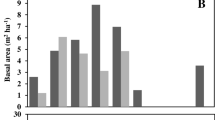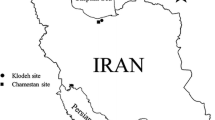Abstract
Estimation of carbon pools and fluxes were conducted in Bruguiera parviflora dominated naturally growing protected mangrove forest in Kuala Selangor Nature Park of Peninsular Malaysia. Above and below-ground carbon pools in seedlings were estimated from destructive methods. While, carbon pools and fluxes in saplings and trees were estimated from the derived allometric biomass equations. Carbon concentrations in different parts of seedlings, saplings and trees; and litter were measured during the dry, wet and intermediate seasons. Soil cores up to 1 m were analyzed to measure carbon concentrations and bulk densities at different depths. Litter standing crop of the study area was measured at the dry, wet and intermediate seasons and the range of total amount of litter standing crop was from 0.66 to 0.88 Mg/ha. Carbon concentration found to vary with the plant and litter parts; and also with the seasons and the range of mean weighted carbon concentration was 40.19 ± 0.87–56.52 ± 1.01 %. The carbon pools in seedling, sapling, tree and litter were 0.69, 0.51, 82.62 and 0.41 Mg C/ha respectively. However, 13.95 Mg C/ha/year of carbon flux was associated with saplings, trees and litter. The estimated carbon pool in the soil (up to 1 m) of the study area was 488.04 Mg C/ha. The findings of this study are the first estimation of carbon pools and fluxes in B. parviflora dominated sites and suggests the potential of this site as a carbon pool.





Similar content being viewed by others
References
Allen SE (1974) Chemical analysis of ecological materials. Blackwell Scientific publication, Oxford
Alongi DM (2009) The energetics of mangrove forests. Springer Science and Business Media BV, New York
Ardö J, Mölder M, El-Tahir BA, Elkhidir HAM (2008) Seasonal variation of carbon fluxes in a sparse savanna in semi arid Sudan. Carbon Bal Manag 3:7. doi:10.1186/1750-0680-3-7
Asch F, Dingkuha M, Dorffling K (2000) Salinity increases CO2 assimilation but reduce growth in field-grown, irrigated rice. Plant Soil 218:1–10
Barford CC, Wofsy SC, Goulden ML, Munger JW, Pyle EH, Urbanski SP, Hutyra L, Saleska SR, Fitzjarrald D, Moore K (2001) Factors controlling longand short-term sequestration of atmospheric CO2 in a mid-latitude forest. Science 294:1688–1691
Barr JG, Engel VC, Fuentes JD, Zieman JC, O’Halloran TL, Smith TJ III, Anderson GH (2010) Controls on mangrove forest-atmosphere carbon dioxide exchanges in western Everglades National Park. J Geophys Res Biogeo. doi:10.1029/2009JG001186
Bouillon SM, Frankignoulle F, Dehairs B, Velimirov A, Eiler H, Etcheber G, Borges AV (2003) Inorganic and organic carbon biogeochemistry in the Gautami Godavari estuary (Andhra Pradesh, India) during pre-monsoon: the local impact of extensive mangrove forests. Global Biogeochem CY 17(4):1114. doi:10.1029/2002GB002026
Bouillon S, Borges AV, eda-Moya EC, Diele K, Dittmar T, Duke NC, Kristensen E, Lee SY, Marchand C, Middelburg JJ, Rivera-Monroy VH, Smith III TJ, Twilley RR (2008) Mangrove production and carbon sinks: a revision of global budget estimates. Global Biogeochem CY 22:1–12 (GB2013). doi: 10.1029/2007GB003052
Bradford JB, Weishampel P, Smith ML, Kolka R, Birdsey RA, Ollinger SV, Ryan MG (2010) Carbon pools and fluxes in small temperate forest landscapes: variability and implications for sampling design. Forest Ecol Manag 259:1245–1254
Cerón-Bretón RM, Cerón-Bretón JG, Sánchez-Junco RC, Damián-Hernández DL, Guerra-Santos JJ, Muriel-Garcia M, Cordova-Quiroz AV (2011) Evaluation of carbon sequestration potential in mangrove forest at three estuarine sites in Campeche Mexico. Int J Energy Environ 5(4):487–494
Conant RT, Klopatek JM, Malin RC, Klopatek CC (1998) Carbon pool and fluxes along an environmental gradient in northern Arizona. Biogeochemistry 43:43–61
Donato DC, Kauffman JB, Murdiyarso D, Kurnianto S, Stidham M, Affiliations MK (2011) Mangroves among the most carbon-rich forests in the tropics. Nat Geos 4:293–297
Ellison AM (2008) Mangrove ecology–applications in forestry and coastal zone management. Aquat Bot 89:77
Fujimoto K, Imaya A, Tabuchi R, Kuramoto S, Utsugi H, Murosushi T (1999) Belowground carbon storage of Micronesian mangrove forests. Ecol Res 14:409–413
Goodale CL, Apps MJ, Birdsey RA, Field CB, Heath LS, Houghton RA, Jenkins JC, Kohlmaier GH, Kurz W, Liu SR, Nabuurs GJ, Nilsson S, Shvidenko AZ (2002) Forest carbon sinks in the Northern Hemisphere. Ecol Appl 12:891–899
Hart PBS, Clinton PW, Allen RB, Nordmeyer AH, Evans G (2003) Biomass and macro- nutrients (above- and below-ground) in a New Zealand beech (Nothofagus) forest ecosystem: implications for storage and sustainable forest management. Forest Ecol Manag 174(1–3):281–294
IPCC (2007) Summary for policymakers. In: Solomon S, Qin D, Manning M, Chen Z, Marquis M, Averyt KB, Tignor M, Miller HL (eds) Climate change 2007: the physical science basis. Contribution of Working Group I to the Fourth Assessment Report of the Intergovernmental Panel on Climate Change. Cambridge University Press, Cambridge
ISME (1993) The economic and environmental values of mangrove forest and their present state of conservation in the South-East Asia and Pacific Region. Mangrove Ecosystems Technical Reports Vol 1. Okinawa: ISME
Kaakinen S, Jolkkonen A, Iivonen S, Vapaavuori E (2004) Growth, allocation and tissue chemistry of Picea abies seedlings affected by nutrient supply during the second growing season. Tree Physiol 24:707–719
Kanninen M, Murdiyarso D, Seymour F, Angelsen A, Wunder S, German L (2007) Do trees grow on money? The implications of deforestation research for policies to promote REDD. CIFOR, Bogor
Kathilankal JC, Mozdzer TJ, Fuentes JD, D’Odorico P, McGlathery KJ, Zieman JC (2008) Tidal influences on carbon assimilation by salt marsh. Environ Res Lett. doi:10.1088/1748-9326/3/4/044010
Kato T, Tang Y (2008) Spatial variability, and major controlling factors of CO2 sink strength in Asian terrestrial ecosystems: evidence from eddy covariance data. Glob Change Biol 14:2333–2348
Kauffman JB, Heider C, Cole TG, Dwire KA, Donato DC (2011) Ecosystem carbon stocks of micronesian mangrove forests. Wetlands 31:343–352
Keeling CD, Bacastow RB, Carter AF, Piper SC, Whorf TP, Heimann M, Mook WG, Roeloffzen H (1989) Aspect of climate variability in the pacific and Western Americans. In: Pererson DH (ed) Geophysical monograph 55. American Geographical Union, Washington DC, pp 165–236
Kennedy RE, Turner DP, Guzy M, Cohen WB (2006) A method to efficiently apply a biogeochemical model to a landscape. Landsc Ecol 21:213–224
Khan MNI, Suwa R, Hagihara A (2007) Carbon and nitrogen pools in a mangrove stand of Kandelia obovata (S., L.) Yong: vertical distribution in the soil–vegetation system. Wetl Ecol Manag 15(2):141–153. doi:10.1007/s11273-006-9020-8
Kimmins JP (2004) Forest ecology: a foundation for sustainable forest management and environmental ethics in forestry. Prentice Hall, NewYork
Komiyama A, Ong JE, Poungparn S (2008) Allometry, biomass and productivity of mangrove forests: a review. Aquat Bot 89:128–137
Körner C (2003) Carbon limitation in trees. J Ecol 91:4–17
Kridiborworn P, Chidthaisong A, Yuttitham M, Tripetchkul S (2012) Carbon sequestration by mangrove forest planted specifically for charcoal production in Yeesarn, Samut songkram. J Sustain Energy Environ 3:87–92
Kristensen E, Bouillon S, Dittmar T, Cyril Marchand (2008) Organic carbon dynamics in mangrove ecosystems: a review. Aquat Bot 89:201–219
Ksawani I, Kmarusaman J, Nurum-Nadhirah MI (2007) Biological diversity assessment of Tok Bali mangrove forest, klantan, Malaysia. WSEAS Transac on Environ Develop 3:7–44
Laffoley D, Grimsditch G (2009) The management of natural coastal carbon sinks. IUCN, Gland
Langner A, Miettinen J, Siegert F (2007) Land cover change 2002–2005 in Borneo and the role of fire derived from MODIS imagery. Glob Change Biol 13:2329–2340
Mahmood H (2004) Biomass, litter production and nutrients in Bruguiera parviflora dominated mangrove forest ecosystem at Kuala Selangor, Malaysia. PhD thesis. Universiti Putra Malaysia
Mahmood H, Saberi O, Japar Sidik B, Misri K (2005) Litter flux in Kuala Selangor Nature Park mangrove forest Malaysia. Indian J For 28(3):233–238
Mahmood H, Saberi O, Japar Sidik B, Kusnan M (2008) Net primary productivity of Bruguiera parviflora (Wight & Arn.) dominated mangrove forest at Kuala Selangor, Malaysia. For Ecol Manag 255:179–182
Mitra A, Sengupta K, Banerjee K (2011) Standing biomass and carbon storage of above-ground structures in dominant mangrove trees in the Sundarbans. For Ecol Manag 261:1325–1335
Murdiyarso D, Donato D, Kauffman JB, Kurnianto S, Stidham M, Kanninem M (2009) Carbon storage in mangrove and peat land ecosystems- a preliminary account from plots in Indonesia. Working paper 48, Center for International Forestry Research
Ong JE (1982) Mangroves and aquaculture in Malaysia. Ambio 11(5):252–257
Ong JE (1993) Mangroves -a carbon source and sink. Chemosphere 27:1097–1107
Oren R, Ellsworth DS, Johnsen KH, Phillips N, Ewers BE, Maier C, Schafer KVR, McCarthy H, Hendrey G, McNulty SG, Katul GG (2001) Soil fertility limits carbon sequestration by forest ecosystems in a CO2-enriched atmosphere. Nature 411:469–472
Page SE, Siegert F, Rieley JO, Boehm H-DV, Jaya A, Limin S (2002) The amount of carbon released from peat and forest fires in Indonesia during 1997. Nature 420:61–65
Rattan L (2008) Sequestration of atmospheric CO2 in global carbon pools. Energy Environ Sci 1:86–100
Salazar S, Sanchez LE, Galindo P, Santa-Regina I (2010) Above-ground tree biomass equations and nutrient pools for paraclimex chestnut stand and for a climax oak stand in the Sierra de Francia Mountains, Salamanca, Spain. Sci Res Essays 5(11):129–1301
Santa Regina I (2000) Biomass estimation and nutrient pools in tour Quercus pyrenaica in Sierra de Gata Mountains, Salamanca, Spain. For Ecol Manag 132:127–141
Schädel C, Blöchl A, Richter A, Hoch G (2009) Quantification and monosaccharide composition of hemicelluloses from different plant functional types. Plant Physiol Bioch 47(1):1–9
Spalding MD, Blasco F, Field CD (1997) World mangrove atlas. The International Society for Mangrove Ecosystems, Okinawa
Valiela I, Bowen JL, York JK (2001) Mangrove forests: one of the world’s threatened major tropical environments. Bioscience 51:807–815
Waring RH, Running SW (1998) Forest ecosystems-analysis at multiple scales. Academic Press, San Diego
Watson GJ (1928) Malayan forest record 6: mangrove forests of the Malay Peninsula. Fraser and Neave Ltd., Singapore
Zha T, Xing Z, Wang KY, Kellomäki S, Barr AG (2007) Total and component carbon fluxes of a scots pine ecosystem from chamber measurement and eddy covariance. Ann Bot 99:345–353
Acknowledgments
The authors wish to thank the Department of Biology, University Putra Malaysia and the Malaysian Natural Society for their financial and logistic support throughout the study period.
Author information
Authors and Affiliations
Corresponding author
Rights and permissions
About this article
Cite this article
Hossain, M. Carbon pools and fluxes in Bruguiera parviflora dominated naturally growing mangrove forest of Peninsular Malaysia. Wetlands Ecol Manage 22, 15–23 (2014). https://doi.org/10.1007/s11273-013-9318-2
Received:
Accepted:
Published:
Issue Date:
DOI: https://doi.org/10.1007/s11273-013-9318-2




